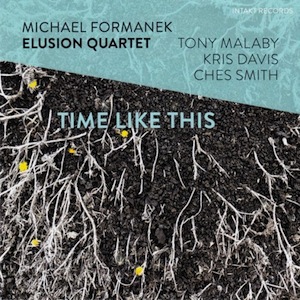Label: Losen Records, 2018
Personnel - Oyvind Nypan: guitar; Ben Wendel: tenor saxophone; Taylor Eigsti: piano; Joe Martin: bass; Justin Faulkner: drums.
Norwegian guitarist Oyvind Nypan traveled to New York City with the dream of recording his own tunes with some of his favorite music makers. And the dream came true and with a happy ending, which is the album in question, suggestively entitled Big City and featuring eminent musicians such as saxophonist Ben Wendel, pianist Taylor Eigsti, bassist Joe Martin, and drummer Justin Faulkner.
For a quintet that had never played together before, there’s a gluing essence in their musical narrative and an exceptional energy associated with the city. This is particularly noticeable not only on the opener, “The Greeting”, which combines a cool bass groove, exquisite backbeat, and mercurial solos by Wendel and Nypan, but also on “Come What May”, an elated post-bop with labyrinthine spirals and expeditious diagonals, and “Grasstopper”, a playful if twisted blues with bop fragments and hard-swinging eruptions. Both these tunes bridge tradition and innovation with an infallible sense of freshness.
Nypan develops an urban glow as he navigates guitar frets. Despite the simplicity in structure, he’s definitely out of the so-called Scandinavian jazz where a more contemplative approach is usually taken. Nonetheless, he can certainly dig a charming ballad like “Starfall” and convey a great deal of emotional fragility.
Getting a look at the title “You Old Tasmanian Devil You”, one may expect to find some irreverence and swiftness, but, instead, the song transpires an airy, laid-back spiritual aura that assuredly steps into modal territory. “Close To The Sun” keeps the affirmative vibe going with a brisker 6/8 time signature and quick-witted statements by the bandleader and Eigsti, who comfortably convert sequences of notes into emotions.
Another tune that immediately caught my ear was “Kung Kong”. Besides the heart-on-sleeve classical lyricism brought in by Eigsti’s comping, you will definitely enjoy the eloquent interplay between saxophone and guitar.
Big City marks an important next step in the continuing evolution of Nypan, a gifted guitarist who deserves more opportunities to shine. I’m glad that New York and its musicians gave him what he needed for now.
Grade A-
Favorite Tracks:
01 - The Greeting ► 02 - You Old Tasmanian Devil You ► 05 - Kung Kong








































